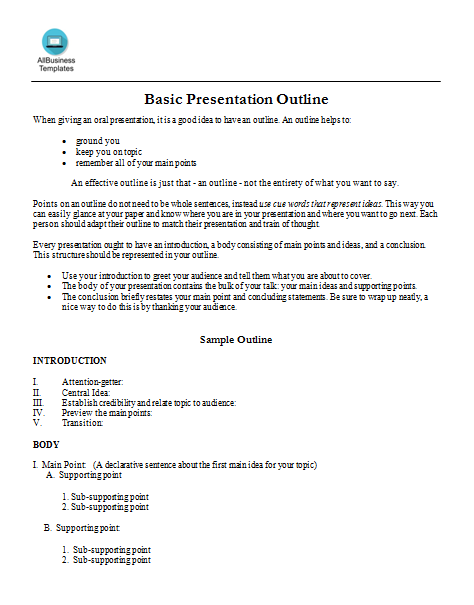Basic Presentation Outline
Save, fill-In The Blanks, Print, Done!

Download Basic Presentation Outline
Microsoft Word (.docx)Or select the format you want and we convert it for you for free:
- This Document Has Been Certified by a Professional
- 100% customizable
- This is a digital download (30.78 kB)
- Language: English
- We recommend downloading this file onto your computer.
How to make a great presentation? The best way to start is to download this Free Basic Presentation Outline template now!
Every day brings new projects, emails, documents, and task lists, and often it is not that different from the work you have done before. Many of our day-to-day tasks are similar to something we have done before. Outline Templates are needed when you are making a presentation or doing any complex assignment. Making the template including various sections can be really troublesome. In order to avoid that you can now download this Outline Template straight from the website. The free Outline Templates in our website come with readymade layouts where you just have to put in the data and you are done. When giving an oral presentation, it is a good idea to have an outline. An outline helps to:
- ground you
- keep you on topic
- remember all of your main points
An effective outline is just that - an outline - not the entirety of what you want to say.
Points on an outline do not need to be whole sentences, instead use cue words that represent ideas. This way you can easily glance at your paper and know where you are in your presentation and where you want to go next. Each person should adapt their outline to match their presentation and train of thought.
Every presentation ought to have an introduction, a body consisting of main points and ideas, and a conclusion. This structure should be represented in your outline.
- Use your introduction to greet your audience and tell them what you are about to cover.
- The body of your presentation contains the bulk of your talk: your main ideas and supporting points.
- The conclusion briefly restates your main point and concluding statements. Be sure to wrap up neatly, a nice way to do this is by thanking your audience.
Introduction
I. Attention-getter:
II. Central Idea:
III. Establish credibility and relate topic to audience:
IV. Preview the main points:
V. Transition:
Body
I. Main Point: (A declarative sentence about the first main idea for your topic)
A. Supporting point
1. Sub-supporting point
2. Sub-supporting point
B. Supporting point:
1. Sub-supporting point
2. Sub-supporting point
C. Supporting point: (If needed)
1. Sub-supporting point
2. Sub-supporting point Transition:
II. Main Point: (A declarative sentence about the second main idea for your topic)
A. Supporting point
1. Sub-supporting point
2. Sub-supporting point
B. Supporting point
1. Sub-supporting point
2. Sub-supporting point
C. Supporting point: (If needed)
1. Sub-supporting point
2. Sub-supporting point Transition:
III. Main Point: (A declarative sentence about the third idea about your topic, if needed)
A. Supporting point
1. Sub-supporting point
2. Sub-supporting point
B. Supporting point
1. Sub-supporting point
2. Sub-supporting point
C. Supporting point: (If needed)
1. Sub-supporting point
2. Sub-supporting point Transition:
Conclusion
I. Summary of the main points
II. Restatement of the central idea
III. Closing lines that relate back to the introduction
What are the 3 types of outlines?
Three types of outlines are most commonly used, which are:
Now we provide this standardized Basic Presentation Outline template with text and formatting to help you finish your document faster. Our Templates have helped many people to reach the next level of their success. It's available in an easy-to-modify Microsoft Office format and can be tailored to your personal needs. Leave an unforgettable impression with your speech has never been easier! If time or quality is of the essence, this ready-made speech outline will help you to make the most of the moment! This speech outline template will perfectly suit your needs!
Download this free presentation outline template to help save time and energy while drafting presentations for work, academics or personal purposes. Choose from a range of samples that are easy to use and convenient to print to organize your content in an orderly fashion to make a presentation that comprehensively conveys all the requisite information.
DISCLAIMER
Nothing on this site shall be considered legal advice and no attorney-client relationship is established.
Leave a Reply. If you have any questions or remarks, feel free to post them below.
Related templates
Latest templates
Latest topics
- GDPR Compliance Templates
What do you need to become GDPR compliant? Are you looking for useful GDPR document templates to make you compliant? All these compliance documents will be available to download instantly... - Google Docs Templates
How to create documents in Google Docs? We provide Google Docs compatible template and these are the reasons why it's useful to work with Google Docs... - IT Security Standards Kit
What are IT Security Standards? Check out our collection of this newly updated IT Security Kit Standard templates, including policies, controls, processes, checklists, procedures and other documents. - Letter Format
How to format a letter? Here is a brief overview of common letter formats and templates in USA and UK and get inspirited immediately! - Google Sheets Templates
How to work with Google Sheets templates? Where to download useful Google Sheets templates? Check out our samples here.
cheese


